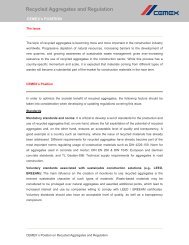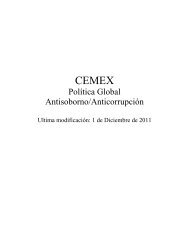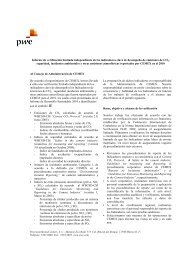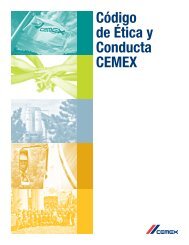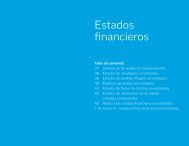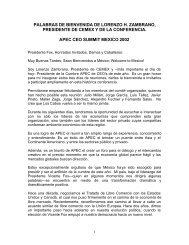building a STRONGER foundation - Cemex
building a STRONGER foundation - Cemex
building a STRONGER foundation - Cemex
You also want an ePaper? Increase the reach of your titles
YUMPU automatically turns print PDFs into web optimized ePapers that Google loves.
CEMEX, S.A.B. DE C.V. AND SUBSIDIARIES<br />
Notes to the Consolidated Financial Statements – (Continued)<br />
As of December 31, 2010, 2009 and 2008<br />
(Millions of Mexican pesos)<br />
The amounts in the statements of operations, the statements of cash flows and the statement of changes in stockholders’ equity are presented<br />
in nominal pesos. The restatement adjustments as of December 31, 2007, the date the inflationary accounting was discontinued, are part of the<br />
carrying amounts. When moving back from a low-inflation to a high-inflation environment, the initial restatement factor should consider the<br />
cumulative inflation since the last time in which inflationary accounting was applied.<br />
Upon adoption of MFRS B-10 on January 1, 2008, the accumulated result for holding non-monetary assets as of December 31, 2007 included<br />
in “Other equity reserves” (note 16B) was reclassified to “Retained earnings,” representing a decrease in this caption on such date of<br />
approximately Ps97,722.<br />
Statements of cash flows<br />
The statements of cash flows present cash inflows and outflows in nominal currency, and exclude inflation effects and unrealized foreign<br />
exchange effects. The statements of cash flows for the years ended December 31, 2009 and 2008 consider the classification of CEMEX’s<br />
operations in Australia as discontinued operations.<br />
The statements of cash flows exclude the following transactions that did not represent sources or uses of cash: a) in 2010, the effects of the<br />
exchange of a portion of CEMEX’s perpetual debentures into notes maturing in 2020 for US$1,067 and notes maturing in 2017 for €115 (note<br />
12A), which represented a net increase in debt of Ps15,437, a reduction in equity’s non-controlling interest of Ps20,838 and an increase in<br />
equity’s controlling interest of Ps5,401; meanwhile, in 2009, the effects of the exchange of promissory notes issued in Mexico (“Certificados<br />
Bursátiles” or “CBs”) into mandatorily convertible securities (note 12A), which represented a reduction in debt of Ps4,007, an increase in<br />
other financial obligations of Ps2,036 and an increase in stockholders’ equity of Ps1,971 (net of issuance expenses); b) in 2010, 2009 and<br />
2008, the increase in stockholders’ equity associated with the capitalization of retained earnings for Ps5,481, Ps4,373 and Ps6,794,<br />
respectively (note 16A); c) in 2010 and 2009, the increase in stockholders’ equity associated with CPOs issued as part of the executive stockbased<br />
compensation for Ps312 and Ps163, respectively (note 16A); and d) in 2010 and 2009, a decrease of Ps2,911 and an increase of<br />
Ps2,245, respectively, in taxes payable as a result of the Mexican tax reform of 2009, which were recognized against retained earnings (notes<br />
15A and 16B).<br />
Migration to International Financial Reporting Standards<br />
In November 2008, the Mexican National Banking and Securities Commission (“CNBV”) published regulations requiring registrants whose<br />
shares are traded on the MSE to adopt International Financial Reporting Standards (“IFRS”) as issued by the International Accounting Standards<br />
Board (“IASB”) no later than January 1, 2012. Earlier adoption was allowed following certain requirements published by the CNBV.<br />
On August 31, 2010, MFRS Interpretation 19 was issued by CINIF requiring disclosure by companies in process of adoption of IFRS of any<br />
obligation and/or decision to adopt IFRS, the expected date of adoption of IFRS and the estimated impact of the adoption on the financial<br />
statements. The interpretation is effective for all financial statements issued on or after September 30, 2010.<br />
CEMEX will adopt IFRS, as issued and interpreted by the IASB, beginning on January 1, 2012. In order to comply with the requirements of the<br />
CNBV, CEMEX has gathered the necessary resources required in the IFRS conversion effort and is in the process of identifying and<br />
measuring the necessary adjustments. As of December 31, 2010, the migration process to IFRS is in progress and CEMEX cannot estimate<br />
the effects on its consolidated financial statements.<br />
B) PRINCIPLES OF CONSOLIDATION<br />
The consolidated financial statements include those of CEMEX, S.A.B. de C.V. and the entities in which the Parent Company holds, directly<br />
or through subsidiaries, more than 50% of their common stock and/or has control. Control exists when CEMEX has the power, directly or<br />
indirectly, to govern the administrative, financial and operating policies of an entity in order to obtain benefits from its activities. Balances<br />
and operations between related parties are eliminated in consolidation.<br />
Investments in associates are accounted for by the equity method when CEMEX has significant influence, which is generally presumed with<br />
an equity interest between 10% and 50% in public companies, and between 25% and 50% in non-public companies, unless it is proven in<br />
each specific case that CEMEX has significant influence with a lower percentage. The equity method reflects, in the financial statements, the<br />
investment’s original cost and the proportional interest of the holding company in the associate’s equity and earnings after acquisition,<br />
considering the effects of inflation, if applicable.<br />
Under MFRS B-8, “Consolidated or Combined Financial Statements,” beginning in 2009, the financial statements of joint ventures, which are<br />
those entities in which CEMEX and other third-party investors have agreed to exercise joint control, are recognized under the equity method.<br />
Until December 31, 2008, financial statements of such joint ventures were consolidated through the proportional integration method,<br />
considering CEMEX’s interest in the results of operations, assets and liabilities of such entities, based on International Accounting Standard<br />
No. 31, “Interest in Joint Ventures.” No significant effects resulted from the adoption of MFRS B-8 in 2009, considering that CEMEX sold its<br />
joint venture investments in Spain in 2008 (note 11A).<br />
F-9



